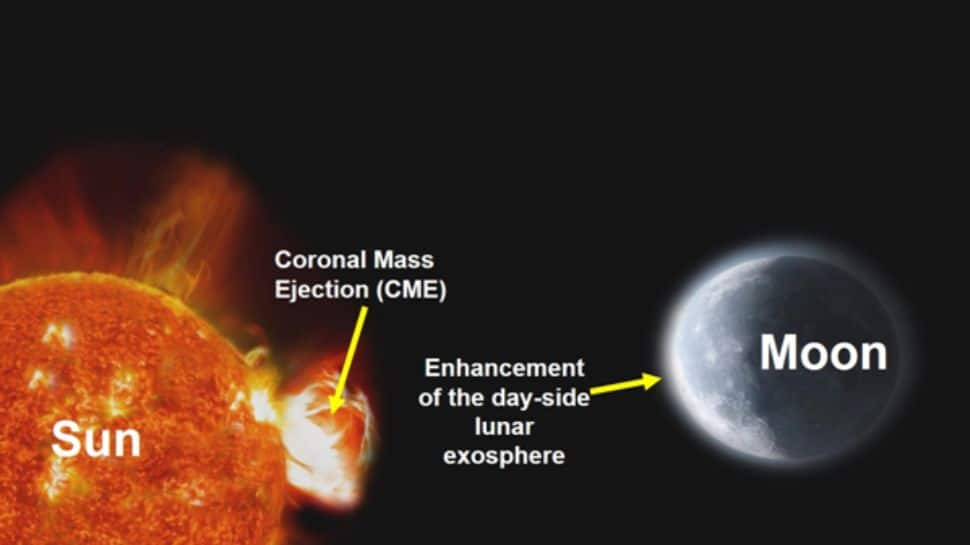Science
ISRO’s Chandrayaan-2 Makes Historic Lunar Observation of Solar Ejections

The Indian Space Research Organisation (ISRO) has achieved a remarkable milestone in space exploration. Its lunar orbiter, Chandrayaan-2, has become the first spacecraft to observe the effects of Coronal Mass Ejections (CMEs) from the Sun on the Moon’s exosphere. This groundbreaking observation has garnered significant attention within the global space community, marking a pivotal moment in the study of lunar science.
Understanding Coronal Mass Ejections
Coronal Mass Ejections are massive bursts of solar wind and magnetic fields that are released from the Sun’s corona. These events can propel billions of tons of charged particles into space, impacting celestial bodies, including the Moon. On May 10, 2024, a series of CMEs struck the Moon, leading to a notable increase in the pressure of the lunar exosphere—the Moon’s extremely sparse atmosphere.
Utilizing the Chandra Atmospheric Composition Explorer-2 (CHACE-2) instrument aboard Chandrayaan-2, ISRO scientists observed that the number density of neutral atoms and molecules in the lunar exosphere increased dramatically, exceeding theoretical expectations that had not been validated until this observation.
Implications for Future Lunar Missions
The Moon’s exosphere is classified as a surface boundary exosphere, which makes it particularly sensitive to solar activity due to the absence of a global magnetic field. The recent CME event resulted in the liberation of atoms from the lunar surface, temporarily altering atmospheric conditions. ISRO stated that these findings not only enhance our scientific understanding of lunar space weather but also have significant implications for future lunar missions and the development of human habitats on the Moon.
As humanity moves towards potential lunar colonization, data from this historic study will be instrumental in shaping the design and construction of lunar bases. The research, titled “Impact of a Coronal Mass Ejection on the Lunar Exosphere as Observed by CHACE-2 on the Chandrayaan-2 Orbiter,” was published in the esteemed journal Geophysical Research Letters on August 16, 2025.
ISRO’s exploration emphasizes that the Moon’s atmosphere is exceedingly thin, where gas atoms and molecules exist in a state of near isolation. The interaction of solar radiation, solar winds, and meteoritic impacts contributes to the exosphere’s formation, underscoring its vulnerability to variations in solar activity.
The implications of this discovery extend beyond theoretical knowledge. ISRO highlighted that understanding the effects of CMEs on the Moon is crucial for constructing scientific bases that would need to withstand such extreme events. Lunar base architects must consider how these solar phenomena can temporarily alter the lunar environment, ensuring that habitats are designed to cope with such challenges.
This unprecedented observation from Chandrayaan-2 marks a significant leap in lunar science, affirming India’s growing stature as a leader in space exploration. Through these innovative efforts, ISRO continues to push the boundaries of our understanding of the cosmos, paving the way for future discoveries that will shape humanity’s relationship with the Moon and beyond.
-

 World5 months ago
World5 months agoSBI Announces QIP Floor Price at ₹811.05 Per Share
-

 Lifestyle5 months ago
Lifestyle5 months agoCept Unveils ₹3.1 Crore Urban Mobility Plan for Sustainable Growth
-

 Science4 months ago
Science4 months agoNew Blood Group Discovered in South Indian Woman at Rotary Centre
-

 World5 months ago
World5 months agoTorrential Rains Cause Flash Flooding in New York and New Jersey
-

 Top Stories5 months ago
Top Stories5 months agoKonkani Cultural Organisation to Host Pearl Jubilee in Abu Dhabi
-

 Sports4 months ago
Sports4 months agoBroad Advocates for Bowling Change Ahead of Final Test Against India
-

 Science5 months ago
Science5 months agoNothing Headphone 1 Review: A Bold Contender in Audio Design
-

 Top Stories5 months ago
Top Stories5 months agoAir India Crash Investigation Highlights Boeing Fuel Switch Concerns
-

 Business5 months ago
Business5 months agoIndian Stock Market Rebounds: Sensex and Nifty Rise After Four-Day Decline
-

 Sports4 months ago
Sports4 months agoCristian Totti Retires at 19: Pressure of Fame Takes Toll
-

 Politics5 months ago
Politics5 months agoAbandoned Doberman Finds New Home After Journey to Prague
-

 Top Stories5 months ago
Top Stories5 months agoPatna Bank Manager Abhishek Varun Found Dead in Well









